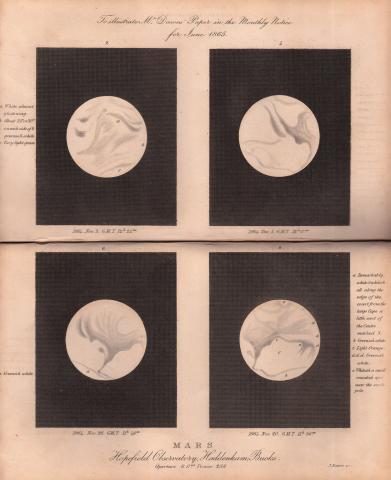- This topic has 2 replies, 2 voices, and was last updated 5 years, 2 months ago by
 David Strange.
David Strange.
-
AuthorPosts
-
12 October 2020 at 7:31 pm #574757
 David StrangeParticipant
David StrangeParticipant
In researching a talk about Lockyer’s observations of Mars I came across this wonderful plate of Dawes’ drawing of his famous “Forked Bay”.
From Monthly Notes of RAS – June 9th 1865
“On the Planet Mars” – by Rev. W.R. Dawes
“…….Another interesting object was the forked shading, depicted on Nov. 10th , 14th & 20th.
This object I saw repeatedly in 1852 as an oval bay with a regular coast, and never once expected it to be divided, or irregular in its outline. But, in 1862 Sep 22nd with the Alvan Clark’s 8.25” O.G. I discovered it to be distinctly forked and depicted it so at the time. During the last opposition however, I never obtained a moderately good view of that part of the disk without plainly perceiving this curious forked shape – giving the impression of two very wide mouths of a river, which however I could never trace. This feature I have never seen depicted in any drawings of the planet. In Mr. Lockyer’s excellent pictures representing his observations in 1862, that portion of the disk is repeatedly introduced, but it was never seen to be divided.
It will form a very interesting object for scrutiny in future oppositions, to ascertain whether its forked character is permanent or variable. It may be, that the sea has receded from that part of the coast and left a tongue of land exposed.”
I never realised he originally saw it as a fork with 4 prongs, I’ve only seen it with two!
David
Attachments:
13 October 2020 at 9:02 am #583237 Dr Richard John McKimParticipant
Dr Richard John McKimParticipantDawes was a superb observer, for sure. The original drawings for 1864-65 that were used to prepare the engravings for that RAS publication are held in the Mars Section archives. The engravings are faithful reproductions. If you look at the bottom right drawing on the plate there do appear to be four forks, but the one nearest the limb is actually Margaritifer Sinus. In high resolution maps (such as Ebisawa’s, uploaded to the Section website) there is the usual partly resolved broad fork, with lighter shading between, and then a third ‘prong’ on the following or W. side, the latter (which Ebisawa called Brangaena) very thin leading to a very small dark spot at the north end. This can be seen in good current images of the region and I have seen it visually this year. It is of course harder to discover something than for a later observer to confirm it! In 1941 the Pic du Midi observers resolved the westernmost prong of the Meridiani Sinus into two closely spaced prongs, also shown on the Ebisawa map, though it is not a constant feature. So that would make four prongs. Historically there were always large differences in the drawings of this region, with some observers resolving two well-defined forks and others seeing the Sinus Sabaeus-Meridiani region like a sort of meat cleaver.
Although Dawes saw the planet briefly at the next opposition, these views of 1864-65 were his last ones. His excellent series from 1852 was reproduced in a small engraving by Proctor, and used in his well-known map, but they have never been reproduced from the originals.
It is odd that Dawes himself never tried to chart the planet.
13 October 2020 at 3:52 pm #583239 David StrangeParticipant
David StrangeParticipantThanks Richard, I can see that now! I think I misread the scale of the drawing!
David
-
AuthorPosts
- You must be logged in to reply to this topic.
